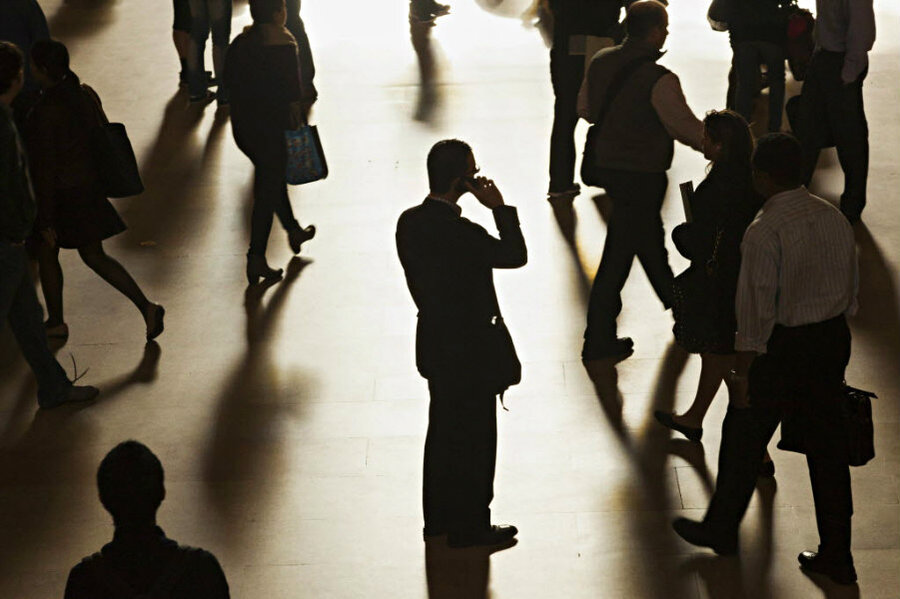Mobile manners: How Americans are navigating cell phone etiquette
Loading...
Most Americans think it’s rude to use a cell phone in a social setting – but they do it anyway.
That’s according to a new Pew Research Center report on views around mobile phone etiquette. The findings highlight both technology’s growing impact on social interactions and society’s struggle to strike a balance between conventional courtesies and ubiquitous electronics.
“For many Americans, cell phones are always present and rarely turned off – and this constant connectivity creates new social challenges,” the report, published Wednesday, found. For instance, “many Americans view [mobile phones] as harmful and distracting to group dynamics, even as they can’t resist the temptation themselves.”
About 92 percent of US adults now own a cell phone, and more than three-quarters of that group say they rarely or never turn off their phones, according to the survey. That constant state of connectedness has led Americans to create and negotiate new norms around the use of their devices in social gatherings and public places.
Take the theater industry, which has for years wrestled with accommodating an increasingly plugged-in public with the time-honored conventions of the theater house. The results have been mixed: On the one hand, Tony winner Patti LuPone reportedly snatched a cell phone from a texting spectator during a show; on the other, Disney theatrical producer Tom Schumacher attributed the success of the musical “Newsies” in part to the show’s social media presence.
It’s not just theater. Cell phones and other devices have affected people’s behavior on public transport, in restaurants, at family gatherings and business meetings, even while walking down the street – indeed, people most frequently use their smartphones in public to look up where they’re going, according to Pew.
Some experts have warned against technology’s negative impact on people’s personal relationships and faculty for communication. Children’s social skills and ability to pick up emotional cues may also be declining as the amount of time they spend in face-to-face interaction decreases, a study from the University of California, Los Angeles found.
But that doesn’t make technology a bad thing, says Jodi R. R. Smith, president and owner of Mannersmith Etiquette Consulting. While the boundaries of propriety do evolve as technology progresses, the bottom line remains the same: “Be aware of your surroundings,” Ms. Smith says.
It’s a rule that applies to almost any situation, whether when looking up directions on a city sidewalk, going to the movies, or talking to someone in person, she notes, adding that the main question a person should keep in mind is: does a device enhance or distract from a social exchange?
“If you and I are having a conversation and someone taps you on the shoulder, and you turn your back on me to have another conversation, that would be extremely rude,” Smith says. The same is true “whether it’s another person or a piece of technology.”
Americans, for the most part, recognize these norms. The Pew study found, for instance, that people’s standards for acceptable behavior vary based on location – 77 percent say it’s OK to use cell phones on the street compared to 38 percent at restaurants and only 5 percent at meetings.
And while young people tend to be more permissive than their elders, Americans of all ages generally trend in the same direction about when it is OK or not to use cell phones in public.
Nearly 80 percent of those who admitted to using their phones at a social gathering also said they did so to post a picture or video of the group, share something that had occurred in the group via text, email, or social media, or engage in some activity that added value to the gathering. Only 30 percent turned to their phones to get away from personal interaction, the report found.
Which shows that etiquette, as Washington Post art critic Philip Kennicott wrote, “is remarkably resilient.”
Taking a selfie in a museum may be disruptive to others, and antithetical to the experience of art, yet given the option, most people will avoid walking through the line of sight and ruining someone else’s photograph. If the power goes off in a nightclub, it’s astonishing how quickly audiences will tune in and scale down their conversations to hear the unamplified music.
The responsibility of ensuring that resilience is maintained, especially among today’s generation of “digital natives,” falls on all of society, according to Smith.
“Technology, on the whole, is a good thing,” she says. “They’re tools. It’s how you use them that makes a difference.”






